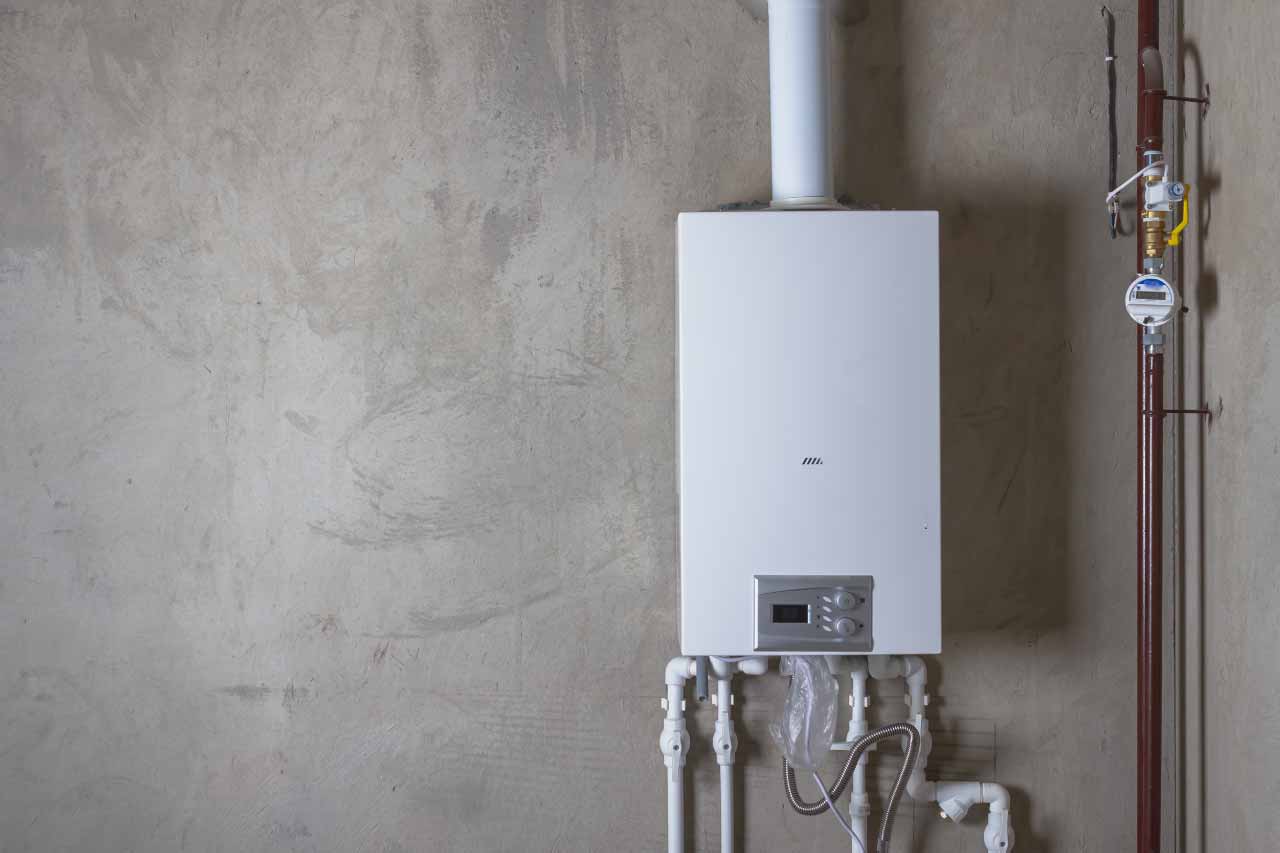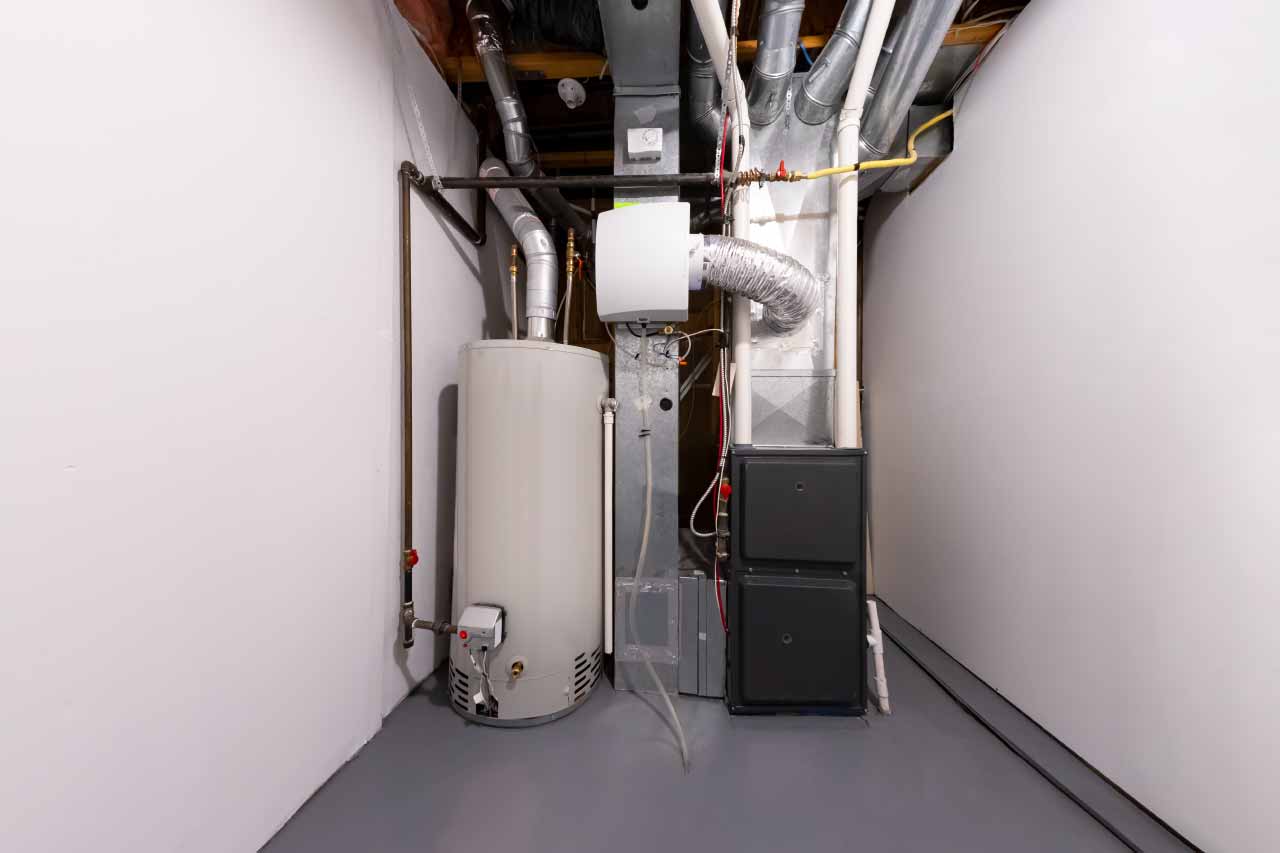

Photo (left): oasisamuel / Adobe Stock
Photo (right): Olga / Adobe Stock
Reviewed by Jeff Botelho, Licensed Journeyman Plumber.Written by HomeAdvisor.
Furnaces and boilers are the two most common heating systems in many American homes today. There’s a widespread misconception that the two terms mean the same thing, but this isn’t true. While both serve the purpose of heating your home, they do it differently. The biggest difference between a boiler and a furnace is that a boiler uses hot water or steam to heat your home, while a furnace uses hot air.
On This Page:
- What Is a Boiler?
- What Is a Furnace?
- Appearance
- Cost
- Upkeep
- Installation
- Life Span
- Environmental Impact
- Is a Boiler or Furnace Better for Your Home?
- Boilers and Furnaces vs. Heat Pumps
What Is a Boiler?
Boilers heat water, turn it into steam or hot water, and then distribute it through a network of pipes to radiators in different rooms of your home. The radiators can be different types—baseboard radiators, cast-iron radiators, and radiant floor heating systems—then transfer heat from the hot water or steam to the room. The fuel that powers a boiler can be oil, electricity, natural gas, or wood pellets.
What Is a Furnace?
Furnaces draw outside air in through a blower, heat it, and distribute it throughout the house via ductwork. The heated air is then released through vents located in various rooms of the house. This type of ducted heat distribution is called forced air. Furnaces are typically powered by natural gas, propane, oil, and electricity, with natural gas-powered furnaces being the most common.
Appearance
Boilers are typically larger and more industrial in appearance. In contrast, furnaces tend to have a more compact, boxier appearance.
| Boiler | Furnace |
|---|---|
| Larger | Compact |
| More industrial-looking | Boxier appearance |
| Takes up more space | Takes up less space |
Boiler
Older water boilers are typically quite tall and cylindrical. “Most boilers manufactured in the last 40 years or so are rectangular in shape,” says Jeff Botelho, Angi Expert Review Board member and Massachusetts-licensed journey-level plumber. “Up until the invention of direct- and power-vent models, they could be found closer to the chimney for exhausting purposes. Today, regulations specify that they go along the wall of your home, which is why most are in the basement or garage.”
Furnace
Older furnaces are small and rectangular. Today’s newer models have tight clearances and fit in much smaller spaces—such as your garage, attic, or inside a utility closet—without much clearance aside from what’s required to remove access covers. Keep in mind that you should always install furnaces with at least a foot of space around every edge to keep them from overheating.
Cost
When comparing boiler versus furnace costs, furnaces are generally more affordable than boilers. This applies to the cost of the furnace itself as well as the installation.
Boiler
Installing a new boiler costs $5,800 on average, with a typical range of between $3,700 and $8,300. How much you pay depends on the fuel type.
- Electric boilers cost around $1,500–$6,500 to install.
- Wood boilers cost around $8,000–$14,000 to install.
- Propane boilers cost around $3,800–$12,000 to install.
Prices can also vary depending on whether your boiler is a standard boiler (which only heats the home), a combination boiler (which heats the house and provides water for showers and taps), or a system boiler (which works the same as a combination boiler but also has a tank that keeps water hot for larger homes).
Other factors that affect the cost include the size and energy efficiency. High-end boilers with extreme energy efficiency can easily surpass five figures.
Furnace
Installing a furnace costs between $2,800 and $6,800. Like a boiler, a couple of factors can affect how much you pay, including the fuel type, furnace size, energy efficiency, and brand.
- Installing a new electric furnace costs around $1,700–$7,000.
- Installing a new gas furnace costs around $2,000–$6,000.
Upkeep
Furnaces are generally more maintenance-intensive than boilers. They have parts more prone to breaking and others that need regular replacing for the furnace to continue functioning properly and efficiently.
Boiler
Other than an annual tune-up service, the maintenance requirements for boilers are quite minimal. They have fewer moving parts, wear out more slowly, and generally require fewer repairs over their lifetime. Repairing a boiler costs between $190 and $630.
Furnace
Furnaces are less costly to install but cost more to maintain. For example, furnace air filters require inspection and replacement every one to three months. “The time between filter replacements relies on many factors, including how dusty the space is, the construction of the building, and how often doors and windows are left open,” says Botelho. Your ductwork may also need cleaning occasionally.
Since furnaces also have more moving parts, they’re more prone to breaking and need more frequent repairs. Repairing a furnace costs between $130 and $490. Like a boiler, furnaces require an annual inspection in which the technician will check for carbon monoxide levels and tune up the system to ensure everything works fine.
Have questions about boiler or furnace installation?Installation
Boilers and furnaces are both relatively complex pieces of machinery. To avoid costly damages and ensure the installation is up to code, hire a professional to install your furnace or boiler rather than attempting to do the job yourself.
Boiler
You could deal with electrical lines, gas lines, or oil tanks, depending on the power source. You might also need to remove walls or floors to install the radiator panels that accompany a boiler system. All this takes significant time, knowledge, and experience, so it’s best to hire a boiler installer near you to do the job. In some states, trying to install a boiler is illegal.
Furnace
Installing furnaces is easier than installing a boiler. But it’s still a job that you shouldn’t attempt yourself. Hire a local furnace installer to ensure the job is done right and safely.
Life Span
Since boilers have fewer moving parts and components that are susceptible to breakage, it also means that the average boiler will last longer than the average furnace. However, regular checkups and proper maintenance can extend the longevity of both heating systems.
Boiler
Boilers can last up to 30 years with proper maintenance.
Furnace
The average life span of a furnace is 15 to 20 years.
Environmental Impact
Both boilers and furnaces offer energy-efficient models. But boilers are inherently more sustainable than furnaces because of their mode of operation.
Boiler
Heating air generally requires more energy than heating water. As a result, a boiler uses less fuel for heating than a furnace, making it the more efficient and sustainable option.
Furnace
Furnaces use more fuel to heat air than a boiler uses to heat water. Furnaces also typically have a shorter life span than boilers, meaning they might need replacing sooner. A furnace replacement costs between $2,800 and $6,800.
Is a Boiler or Furnace Better for Your Home?
Both boilers and furnaces can sufficiently heat your home and make it warm and comfortable. The best option for you depends on your budget, needs, and preferences. Although the initial costs are higher, a boiler may be the better heating system option because it provides more consistent heating since it uses hot water or steam rather than heated air and has lower energy and maintenance costs in the long run.
| Factor | Boiler | Furnace |
|---|---|---|
| Appearance | Larger and more industrial in appearance | Compact, boxier appearance and typically takes up less space |
| Cost | Higher upfront costs at $3,700 –$8,300 | Lower upfront costs at $2,800 – $6,800 |
| Installation | Harder to install and requires a professional | Easier to install but still requires a professional |
| Environmental Impact | More energy-efficient and sustainable | Less efficient and sustainable as it uses more fuel to heat air |
| Upkeep | No major maintenance requirements other than an annual inspection and tune-up service | More maintenance-intensive; air filters need replacing monthly or quarterly and ducts need occasional cleaning |
| Life Span | Up to 30 years | 15 – 20 years |
The type of home you own or where you live can also help you decide on a forced air versus boiler heating system.
For Cold-Weather Climates
If you live in a cold-weather climate where you’ll need to use your heating system for most of the year, a boiler is a better option than a furnace since it tends to heat a home more consistently and evenly. However, a furnace might be the better option if you live in a warmer area where you don’t need to heat your home most of the year.
While you can’t cool your home with only a furnace, you can use the same ductwork to support a central air conditioning system.
For Smaller Homes
Furnaces are better than water boilers for small homes. They take up less space and can fit in utility closets, which frees up potential living space you might lose with a water boiler.
Boilers and Furnaces vs. Heat Pumps
A third type of heating system you might consider is a heat pump, which brings warm air from outside during the colder months and removes warm air from inside during the summer. Heat pumps, as opposed to boilers or furnaces, don’t produce heat; they only move it.
A heat pump has several advantages over boilers and furnaces. First, it can provide a simple, unified system for both heating and cooling your home—unlike a boiler or furnace that can only heat your home. Heat pumps also have the added benefit of removing humidity from the air in your home. Additionally, this home heating system is less expensive to operate since it’s more efficient. The most efficient heat pumps can save up to 50% of your energy bill.
That said, heat pumps cost more to install than furnaces and boilers. For example, the cost of installing a geothermal heat pump can reach $40,000, though you can also get a less expensive ductless mini split unit for between $1,300 and $8,000.
Ready to start your boiler or furnace installation? Types of Furnace Filters & How to Clean Them
Types of Furnace Filters & How to Clean Them  Radiant Floor Heating – How it Works & Benefits
Radiant Floor Heating – How it Works & Benefits  Central HVAC Maintenance – Tips & Advice
Central HVAC Maintenance – Tips & Advice  Increasing Attic Ventilation with Soffit Vents
Increasing Attic Ventilation with Soffit Vents  Baseboard Heaters Radiate the Savings
Baseboard Heaters Radiate the Savings 

The efficiency numbers are very outdated. Modern gas fired furnaces can be > 98% AFUE. Same with gas fired boilers.
A furnace can actually be healthier than a boiler since it can constantly recycle and filter the air in the house.
In my experience, on average boilers are similarly priced and have a similar time and complexity to install as furnaces. Usually 1-2 days for both.
Honestly under DIY it should just say don’t do it, period. These are not DIY projects. Additionally there is a lot more to consider, such as correctly sizing the equipment for the house and its pipes/ducts if they are already present. It is more often than not incorrect to simply replace equipment with new equipment of the same size.